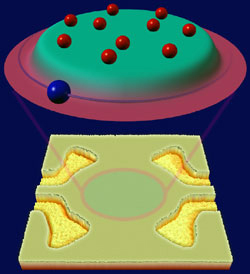Anyon There?

Ordinarily, every particle in quantum theory is neatly classified as either a boson–a particle happy to fraternize with any number of identical particles in a single quantum state–or a fermion, which insists on sole occupancy of its state. Now, in the August Physical Review B, a team shows that certain “quasiparticles” associated with electrons are somewhere in between. In the 21 October PRL, another team proposes a different experimental technique that should reveal these properties in an independent way. The new data confirm previous suspicions that states can exist in this quantum no-man’s-land, and the proposed experiments could make the case even stronger.
Fermions must be alone in their quantum states, while bosons can be among an unlimited number of peers. Almost 30 years ago researchers proposed a third category, “anyons,” where a limited number of particles could inhabit a single state [1]. No one has observed this property directly, but many researchers believed that the strange state of electrons observed in the 1990s in the so-called fractional quantum Hall (FQH) effect qualifies as an anyon.
In the FQH effect, each electron traveling in a thin conducting strip pierced by a strong magnetic field becomes associated with several “vortices,” tiny whirlpools of electric current flowing around field lines (see 1998 Focus story). Experiments demonstrated that the vortices become “quasiparticles” that each have a fraction of the electron’s charge, but researchers hadn’t verified that they are anyons.
Now Vladimir Goldman and his colleagues at Stony Brook University in New York say they have proven the case. They set up two regions in their FQH device, a central “island” with quasiparticles having one-fifth of an electron charge and a narrow ring around it where the quasiparticles had charge one-third. As the researchers varied the magnetic field, they measured the changes in electrical conductivity around the loop. They found exactly the variation that theory predicts for the two types of anyons.
To see why a measurement of one set of particles orbiting around another set would reveal that both sets are anyons, start with the formal definition for anyons, which ultimately leads to their state occupation properties: If two anyons switch places, the wave function that is used to calculate probabilities changes by a so-called phase factor. If you imagine two particles first at rest, then slowly moving around each other to switch places, then returning to their starting places, the process looks something like the mutual orbit of two stars in a binary star system, or dancers executing a do-si-do. But this double swap is equivalent to one particle remaining at rest as the other orbits around it. Goldman’s experiments essentially detect the phase factor resulting from such relative motion of anyons.
Meanwhile, Eduardo Fradkin and his colleagues at the University of Illinois in Urbana-Champaign have devised what they claim is a simpler way to see fractional statistics. They propose placing three electrodes into an FQH strip, so that their separated tips form a triangle. If two of the electrodes are held at the same voltage, currents will travel from each to the third electrode, which is held at a different voltage. The current carriers interfere with each other in a way that depends directly on their anyonic character, and this interference will show up in measurements comparing the random fluctuations–the electrical “noise”–in the two currents.
Frank Wilczek of the Massachusetts Institute of Technology, who came up with the name “anyon” some years ago, says that the Goldman team’s results are “a stunning thing” and that evidence from experiments of the type Fradkin’s group proposes would further solidify the theory of anyons. Wilczek also notes a number of new proposals [2] to look for more exotic anyon states of FQH systems that could form the basis for quantum computers. Such ideas are “futuristic,” he says, “but not as crazy as they used to be.”
–David Lindley
David Lindley is a freelance science writer, now retired. His most recent book is The Dream Universe: How Fundamental Physics Lost Its Way (Penguin Random House, 2020).
References
- J. Leinaas and J. Myrheim, Nuovo Cimento B 37, 1 (1977); G.A. Goldin, R. Menikoff, and D.H. Sharp, “Representations of a local current algebra in nonsimply connected space and the Aharonov-Bohm effect,” J. Math. Phys. 22, 1664 (1981); F. Wilczek, “Magnetic Flux, Angular Momentum, and Statistics,” Phys. Rev. Lett. 48, 1144 (1982)
- S. Das Sarma. M. Freedman, and C. Nayak, “Topologically-Protected Qubits from a Possible Non-Abelian Fractional Quantum Hall State,” Phys. Rev. Lett. 94, 166802 (2005); P. Bonderson, A. Kitaev, and K. Shtengel, “Detecting Non-Abelian Statistics in the nu = 5/2 Fractional Quantum Hall State,” Phys. Rev. Lett. 96, 016803 (2006); A. Stern and B. Halperin, “Proposed Experiments to Probe the Non-Abelian nu = 5/2 Quantum Hall State,” Phys. Rev. Lett. 96, 016802 (2006)


